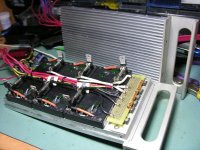AndyH said:I guess I failed to explain the graphs to your satisfaction. I'll try again.
First - the 0, 5.0, 10.0, 15.0, 20.0, and 25.0 numbers across the bottom of the charts are for hours. I'm pretty sure that 24 hours meets your '180 minute' instruction.
Second - you suggest I should run the charts again on a "NEW" cell. I'm very sorry for my communication error. What I ment to say in the post when I typed "brand-new Thunder Sky, Sky Energy, and Shandong HiPower 100Ah prismatics", and later in the comments for the images "New 100Ah Thunder Sky LiFeYP04 - from 4.2V" that the data came from new (unused) cells.
No. The charts I posted are correct. The voltage bleed was from a trio of brand new cells. The data was collected by a calibrated, automated device at 20ºC ambient. The cells were charged on a CC/CV power supply to 1V of their specificed charge voltage, then put on a LaMantia BA402 battery analyzer programmed to finish the charge then log cell voltage for 24 hours.
I'd be happy to re-run the charts on video if you'd like.
Then we DO have a mystery worth investigating Andy. Because I ran this myself quite manually last night. I would suggest we have TWO possibilities here:
1. Test equipment setup.
2. We're testing two entirely different cell chemistries.
When you say "brand new" are you referring to the LiFeYPo4 cells with the Yttrium addition. Or the standard LFP cells?
I'm testing the previous chemistry, but in a new unused battery cell just removed from the box. Though I found NO difference in this among a new cell, a bench queen, and an actual known damaged cell. So I'm not quite guessing here. But they are NOT the LiFeYPo4 cells.
It's like watching paint dry, but if we're doing the same cells, I would suggest forgetting the video, and going to a manual test using a known good DVM. I've been burned by the automated equipment myself several times.
If we are indeed testing the same cells, I would suggest bailing on the pretty graphs and video, and going back to a basic measurement at the cell terminals with a DVM and a stop watch. Disconnect EVERYTHING from the cell after the charge completion. Then connect a DVM to the terminals.
Whenever I see an anomaly like this, I start throwing out test equipment until I get to the simplest form I can.
I measured at the minute for 10, then at the hour, and then every 15 after. In 180 minutes it was over - 3.400 straight up and down.
I kind of did them one at a time which is what took 5 hours. The whole thing can be done in a little over three.
BTW. Since you do have some equipment, perhaps you can help explain something I HAVE been noticing on both charge and discharge. I call it the S curve but that doesn't describe it. It is a little reversal, occurring mostly at pretty good current levels 100-200, on both charge and discharge. On charge, for example, the terminal voltage RISES to 4.16 then REVERSES and falls to 3.92v, then REVERSES AGAIN and rises to the 4.2. On discharge this looks like a drop during current pulses to some low value, like 2.9v for the first five 30second pulse cycles, then a recovery to 3.10 during pulse, gradually declining as expected from there.
Have you seen this? I can pretty much duplicate it at will.
Jack Rickard
http://evtv.me




